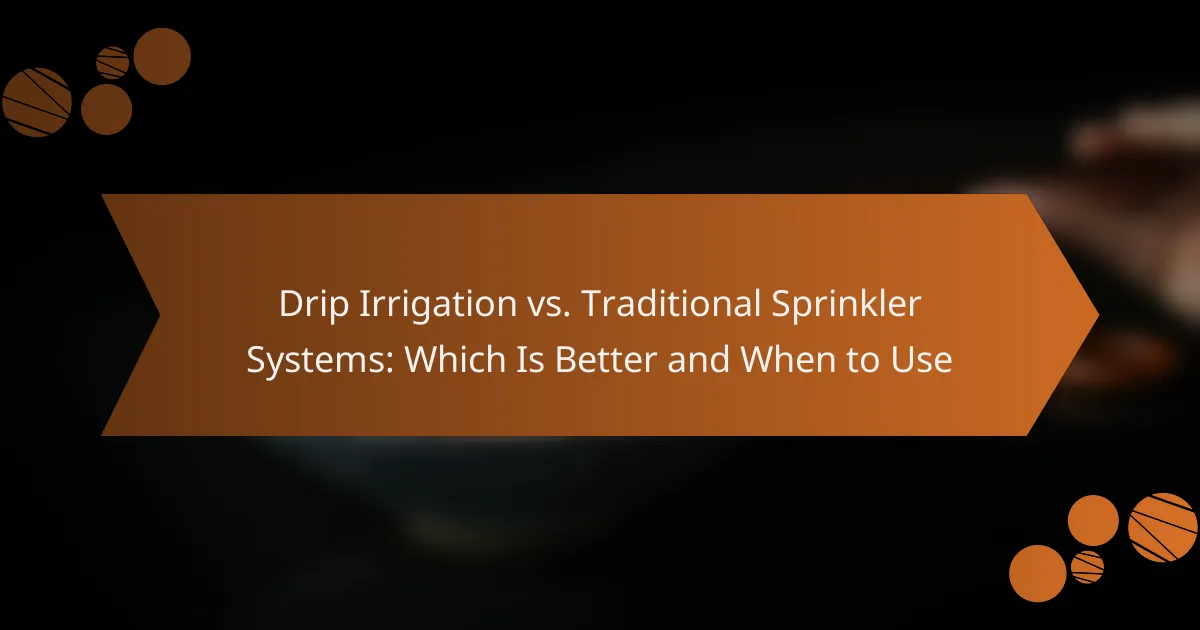When deciding between drip irrigation and traditional sprinkler systems, it’s essential to consider the specific needs of your garden or landscape. Drip irrigation excels in efficient water use and targeted nutrient delivery, making it ideal for urban gardens, while traditional sprinklers are better suited for larger areas requiring uniform coverage. Although drip systems may have higher initial costs, they can lead to long-term savings through reduced water consumption and maintenance. Understanding these differences will help you choose the best option for your gardening goals.
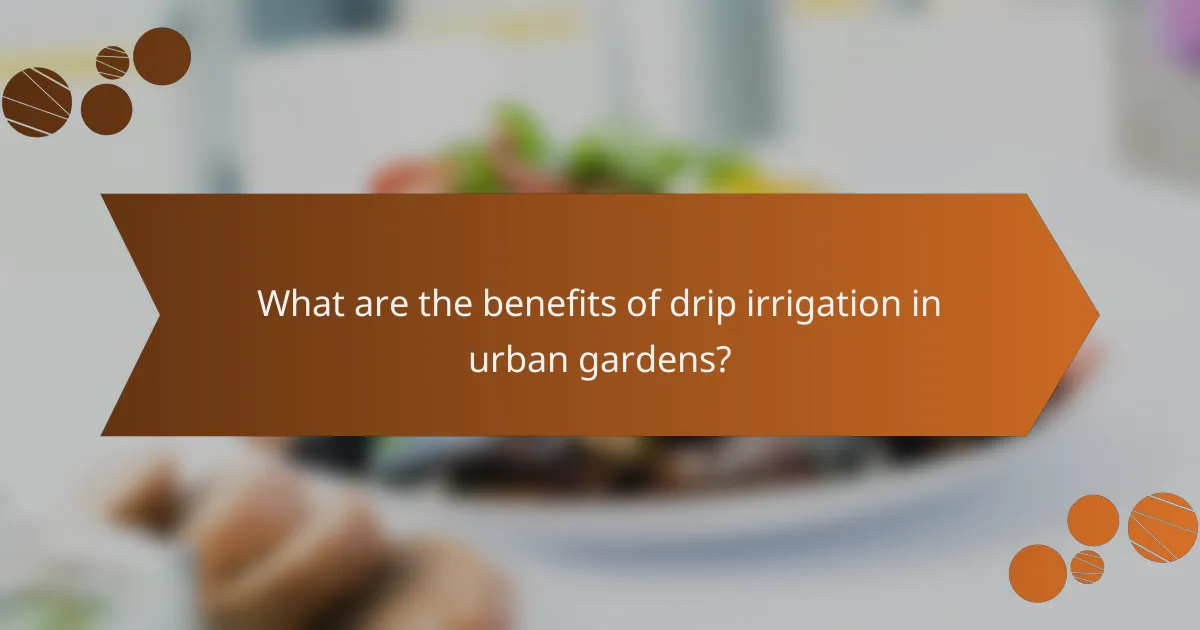
What are the benefits of drip irrigation in urban gardens?
Drip irrigation offers several advantages for urban gardens, primarily through its efficient water use and targeted delivery of nutrients. This method minimizes water waste and can significantly enhance plant growth while reducing maintenance efforts.
Water efficiency
Drip irrigation systems deliver water directly to the root zone of plants, which drastically reduces evaporation and runoff. This targeted approach can save up to 50% more water compared to traditional sprinkler systems, making it ideal for urban areas where water conservation is crucial.
When setting up a drip irrigation system, consider the specific needs of your plants and the local climate. Adjust the flow rates and timing to ensure optimal moisture levels without overwatering.
Reduced weed growth
By applying water directly to the soil where plants are rooted, drip irrigation minimizes moisture on surrounding areas, which helps suppress weed growth. This targeted watering means that only the desired plants receive water, reducing competition for resources.
To further combat weeds, consider using mulch around your plants. This can enhance the effectiveness of drip irrigation by retaining soil moisture and preventing weed germination.
Targeted nutrient delivery
Drip irrigation allows for the incorporation of fertilizers and nutrients directly into the water supply, ensuring that plants receive essential nutrients at their roots. This method can lead to healthier plants and improved yields, especially in urban gardens where soil quality may vary.
When using this system, choose liquid fertilizers that are compatible with drip systems. Regularly monitor nutrient levels to adjust your feeding schedule based on plant growth stages and local soil conditions.
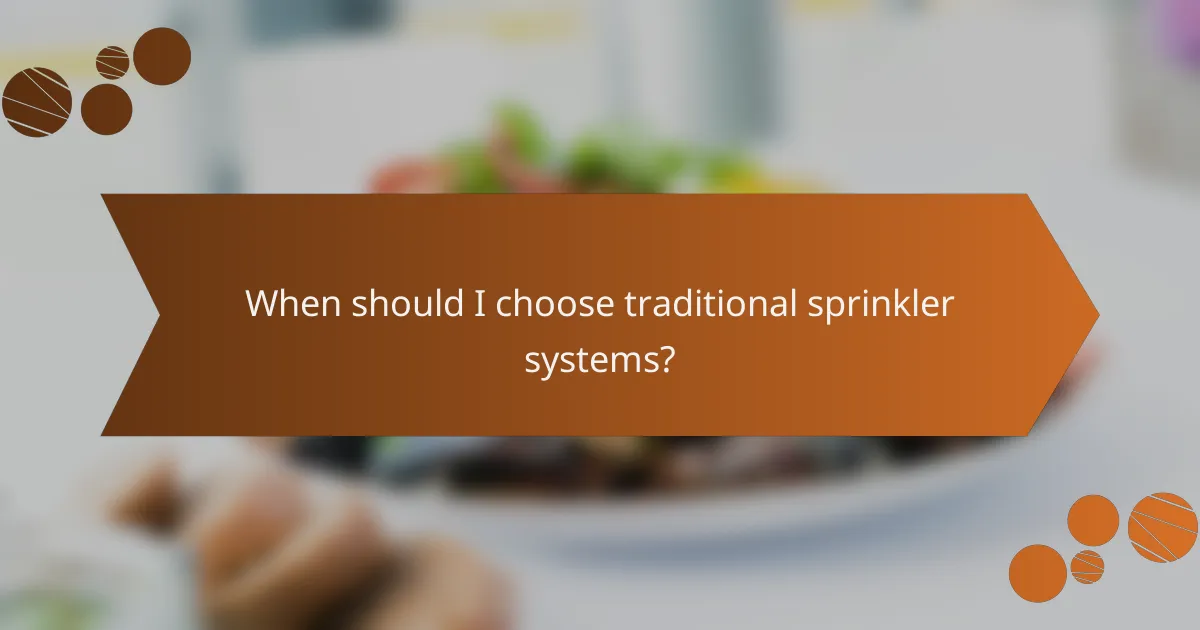
When should I choose traditional sprinkler systems?
Traditional sprinkler systems are ideal when you need to cover large areas efficiently and cost-effectively. They work best for lawns and gardens where uniform water distribution is essential, making them a popular choice for homeowners and landscapers.
Large area coverage
Traditional sprinkler systems excel at watering expansive spaces, such as large lawns or sports fields. They can cover several thousand square feet with a single setup, making them suitable for properties where extensive irrigation is necessary.
Using oscillating or rotating sprinklers can enhance coverage, allowing water to reach every corner of your yard. This is especially beneficial in regions with less frequent rainfall, where maintaining lush greenery is a priority.
Cost-effective for lawns
When considering the cost of installation and maintenance, traditional sprinkler systems often present a more budget-friendly option compared to drip irrigation. The initial investment is typically lower, and they require less specialized equipment.
For homeowners with standard lawns, traditional systems can provide sufficient irrigation without the need for complex setups. This makes them a practical choice for those looking to keep expenses manageable while ensuring their grass remains healthy.
Ease of installation
Installing a traditional sprinkler system is generally straightforward, especially for DIY enthusiasts. Most systems come with clear instructions and can be set up with basic tools, making it accessible for many homeowners.
Additionally, if you need to make adjustments or repairs, traditional systems are often easier to modify than drip systems. This flexibility can save time and money in the long run, allowing for quick fixes and seasonal adjustments.
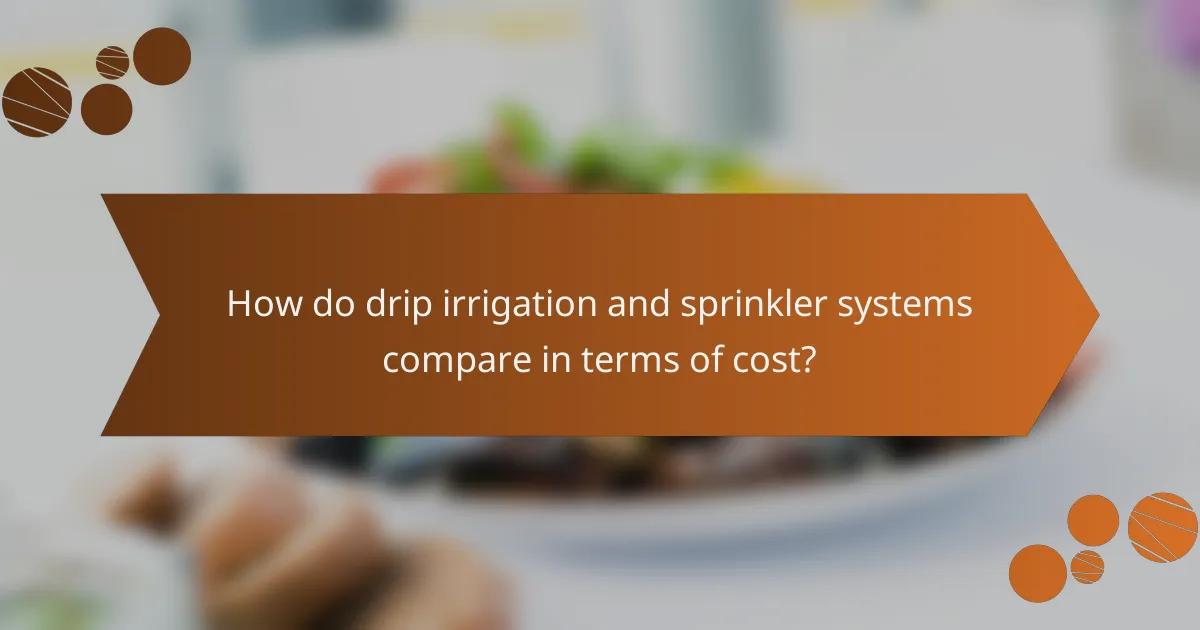
How do drip irrigation and sprinkler systems compare in terms of cost?
Drip irrigation systems generally have higher initial costs compared to traditional sprinkler systems, but they can lead to significant savings over time through reduced water usage and lower maintenance expenses. The choice between them often depends on the specific needs of the garden or agricultural area.
Initial setup costs
The initial setup costs for drip irrigation systems can range from moderate to high, typically between several hundred to a few thousand dollars, depending on the size of the area and complexity of the system. In contrast, traditional sprinkler systems usually have lower upfront costs, often starting in the low hundreds, making them more accessible for small gardens.
When considering installation, drip systems require more components, such as tubing, emitters, and filters, which can increase costs. However, their efficiency in delivering water directly to the roots can justify the investment for larger or more water-sensitive areas.
Long-term maintenance expenses
Long-term maintenance expenses for drip irrigation systems tend to be lower than those for traditional sprinklers. Drip systems are designed to minimize water waste, which can lead to reduced water bills over time. Regular maintenance, such as checking for clogs and replacing emitters, is essential but generally less frequent than the upkeep required for sprinklers.
Sprinkler systems may incur higher costs due to more frequent repairs and adjustments, especially in areas with varying water pressure or where the system is exposed to the elements. Homeowners should consider these ongoing costs when deciding which system to install, as the long-term savings can significantly impact overall budget.
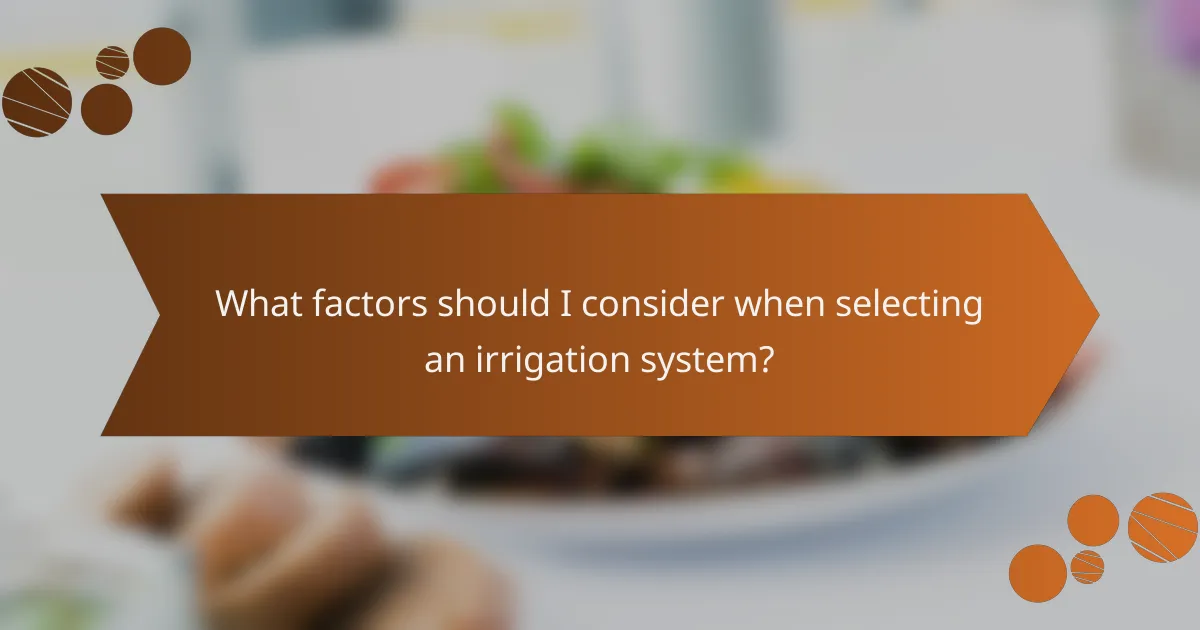
What factors should I consider when selecting an irrigation system?
When selecting an irrigation system, consider soil type, plant water needs, and climate conditions. Each factor influences the efficiency and effectiveness of the irrigation method you choose, impacting water usage and plant health.
Soil type
Soil type significantly affects how water is absorbed and retained. Sandy soils drain quickly, requiring more frequent watering, while clay soils retain moisture longer but may need less frequent irrigation. Understanding your soil’s texture can help you choose a system that delivers the right amount of water efficiently.
For instance, drip irrigation is often more effective in sandy soils, as it delivers water directly to the root zone, minimizing evaporation and runoff. In contrast, traditional sprinkler systems may be more suitable for clay soils, where surface watering can help break up compacted layers.
Plant water needs
Different plants have varying water requirements, which should guide your irrigation system choice. Vegetables and flowering plants often need more consistent moisture, while drought-resistant plants require less frequent watering. Assessing the specific needs of your garden will help you determine the best irrigation approach.
For example, a drip irrigation system can be tailored to deliver precise amounts of water to each plant, making it ideal for diverse gardens. Conversely, a sprinkler system may be more practical for larger areas with uniform water needs.
Climate considerations
Climate plays a crucial role in irrigation planning. Regions with high temperatures and low rainfall may require more efficient systems like drip irrigation to conserve water. In contrast, areas with regular rainfall might benefit from traditional sprinklers that can supplement natural precipitation.
Additionally, consider seasonal variations. In colder climates, systems should be designed to prevent freezing, while in hotter climates, scheduling irrigation during cooler parts of the day can reduce evaporation losses. Always adapt your irrigation strategy to local weather patterns for optimal results.

How does water conservation impact irrigation choices in California?
Water conservation significantly influences irrigation choices in California, where drought conditions are common. Efficient systems like drip irrigation are often preferred for their ability to minimize water waste and deliver moisture directly to plant roots.
Regulatory incentives
California offers various regulatory incentives to promote water-efficient irrigation practices. Programs may include rebates for installing drip irrigation systems or financial assistance for upgrading existing equipment. These incentives encourage farmers and homeowners to adopt technologies that conserve water.
For instance, the California Department of Water Resources provides funding opportunities for water conservation projects, making it financially viable for users to switch to more efficient irrigation methods.
Water usage restrictions
Water usage restrictions in California can dictate the type of irrigation systems that are permissible. During drought periods, local authorities may impose limits on water use, affecting traditional sprinkler systems that tend to waste more water through evaporation and runoff.
Homeowners and farmers must stay informed about local regulations, as these can change frequently. Adopting drip irrigation can help comply with restrictions while ensuring that plants receive adequate moisture, thus maintaining productivity even under stringent water usage guidelines.
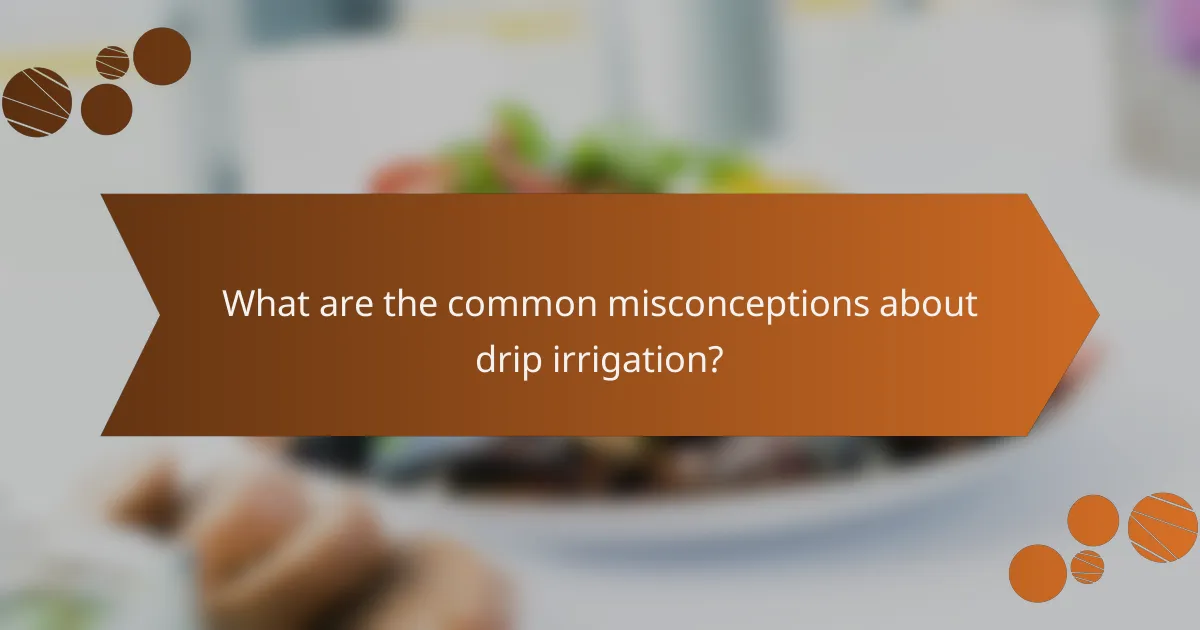
What are the common misconceptions about drip irrigation?
Many misconceptions about drip irrigation stem from misunderstandings regarding its efficiency and application. Some believe it is only suitable for small gardens, while others think it is too expensive or complicated to install and maintain.
Drip irrigation is only for small gardens.
While drip irrigation is often associated with small-scale gardening, it is highly effective for larger agricultural fields as well. Farmers can implement drip systems over extensive areas, allowing for precise water delivery to crops, which can significantly enhance yield and reduce water waste.
Drip irrigation is too expensive to install.
Initial costs for drip irrigation systems can be higher than traditional sprinkler systems; however, the long-term savings on water and increased crop productivity often outweigh these costs. Many farmers find that the investment pays off within a few growing seasons due to reduced water bills and improved crop health.
Drip irrigation requires too much maintenance.
While drip systems do require regular checks for clogs and leaks, maintenance is generally straightforward. Routine inspections and cleaning can prevent most issues, making it a manageable option for both small and large-scale operations. Additionally, many modern systems are designed to minimize maintenance needs.
